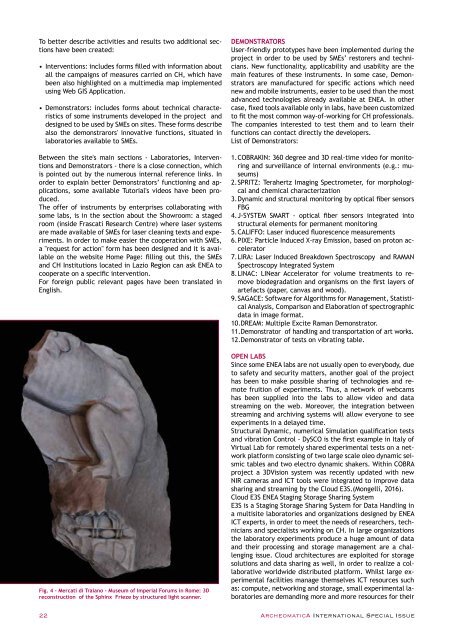Archeomatica International 2017
Special supplement to Archeomatica 3 2017
Special supplement to Archeomatica 3 2017
You also want an ePaper? Increase the reach of your titles
YUMPU automatically turns print PDFs into web optimized ePapers that Google loves.
To better describe activities and results two additional sections<br />
have been created:<br />
• Interventions: includes forms filled with information about<br />
all the campaigns of measures carried on CH, which have<br />
been also highlighted on a multimedia map implemented<br />
using Web GIS Application.<br />
• Demonstrators: includes forms about technical characteristics<br />
of some instruments developed in the project and<br />
designed to be used by SMEs on sites. These forms describe<br />
also the demonstrarors' innovative functions, situated in<br />
laboratories available to SMEs.<br />
Between the site's main sections - Laboratories, Interventions<br />
and Demonstrators - there is a close connection, which<br />
is pointed out by the numerous internal reference links. In<br />
order to explain better Demonstrators’ functioning and applications,<br />
some available Tutorial's videos have been produced.<br />
The offer of instruments by enterprises collaborating with<br />
some labs, is in the section about the Showroom: a staged<br />
room (inside Frascati Research Centre) where laser systems<br />
are made available of SMEs for laser cleaning texts and experiments.<br />
In order to make easier the cooperation with SMEs,<br />
a "request for action" form has been designed and it is available<br />
on the website Home Page: filling out this, the SMEs<br />
and CH Institutions located in Lazio Region can ask ENEA to<br />
cooperate on a specific intervention.<br />
For foreign public relevant pages have been translated in<br />
English.<br />
Fig. 4 - Mercati di Traiano - Museum of Imperial Forums in Rome: 3D<br />
reconstruction of the Sphinx Frieze by structured light scanner.<br />
DEMONSTRATORS<br />
User-friendly prototypes have been implemented during the<br />
project in order to be used by SMEs’ restorers and technicians.<br />
New functionality, applicability and usability are the<br />
main features of these instruments. In some case, Demonstrators<br />
are manufactured for specific actions which need<br />
new and mobile instruments, easier to be used than the most<br />
advanced technologies already available at ENEA. In other<br />
case, fixed tools available only in labs, have been customized<br />
to fit the most common way-of-working for CH professionals.<br />
The companies interested to test them and to learn their<br />
functions can contact directly the developers.<br />
List of Demonstrators:<br />
1. COBRAKIN: 360 degree and 3D real-time video for monitoring<br />
and surveillance of internal environments (e.g.: museums)<br />
2. SPRITZ: Terahertz Imaging Spectrometer, for morphological<br />
and chemical characterization<br />
3. Dynamic and structural monitoring by optical fiber sensors<br />
FBG<br />
4. J-SYSTEM SMART - optical fiber sensors integrated into<br />
structural elements for permanent monitoring<br />
5. CALIFFO: Laser induced fluorescence measurements<br />
6. PIXE: Particle Induced X-ray Emission, based on proton accelerator<br />
7. LIRA: Laser Induced Breakdown Spectroscopy and RAMAN<br />
Spectroscopy Integrated System<br />
8. LINAC: LINear Accelerator for volume treatments to remove<br />
biodegradation and organisms on the first layers of<br />
artefacts (paper, canvas and wood).<br />
9. SAGACE: Software for Algorithms for Management, Statistical<br />
Analysis, Comparison and Elaboration of spectrographic<br />
data in image format.<br />
10.DREAM: Multiple Excite Raman Demonstrator.<br />
11.Demonstrator of handling and transportation of art works.<br />
12.Demonstrator of tests on vibrating table.<br />
OPEN LABS<br />
Since some ENEA labs are not usually open to everybody, due<br />
to safety and security matters, another goal of the project<br />
has been to make possible sharing of technologies and remote<br />
fruition of experiments. Thus, a network of webcams<br />
has been supplied into the labs to allow video and data<br />
streaming on the web. Moreover, the integration between<br />
streaming and archiving systems will allow everyone to see<br />
experiments in a delayed time.<br />
Structural Dynamic, numerical Simulation qualification tests<br />
and vibration Control - DySCO is the first example in Italy of<br />
Virtual Lab for remotely shared experimental tests on a network<br />
platform consisting of two large scale oleo dynamic seismic<br />
tables and two electro dynamic shakers. Within COBRA<br />
project a 3DVision system was recently updated with new<br />
NIR cameras and ICT tools were integrated to improve data<br />
sharing and streaming by the Cloud E3S.(Mongelli, 2016).<br />
Cloud E3S ENEA Staging Storage Sharing System<br />
E3S is a Staging Storage Sharing System for Data Handling in<br />
a multisite laboratories and organizations designed by ENEA<br />
ICT experts, in order to meet the needs of researchers, technicians<br />
and specialists working on CH. In large organizations<br />
the laboratory experiments produce a huge amount of data<br />
and their processing and storage management are a challenging<br />
issue. Cloud architectures are exploited for storage<br />
solutions and data sharing as well, in order to realize a collaborative<br />
worldwide distributed platform. Whilst large experimental<br />
facilities manage themselves ICT resources such<br />
as: compute, networking and storage, small experimental laboratories<br />
are demanding more and more resources for their<br />
22 ArcheomaticA <strong>International</strong> Special Issue


















